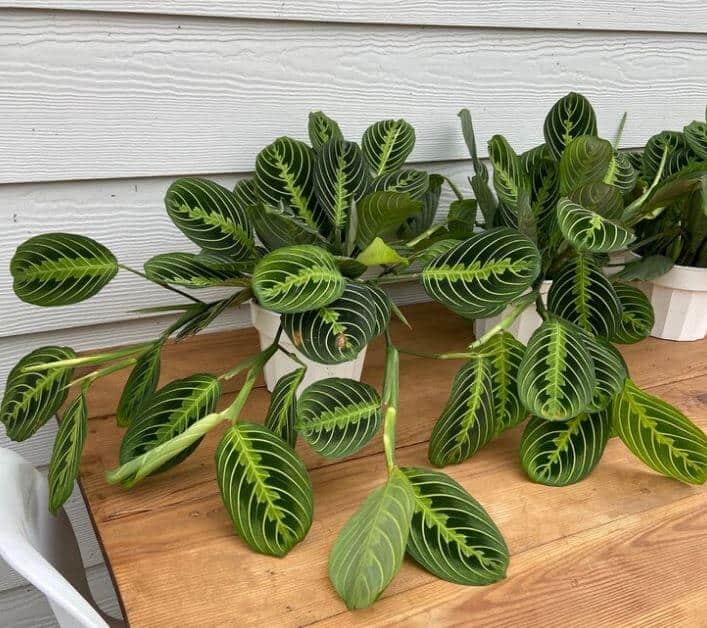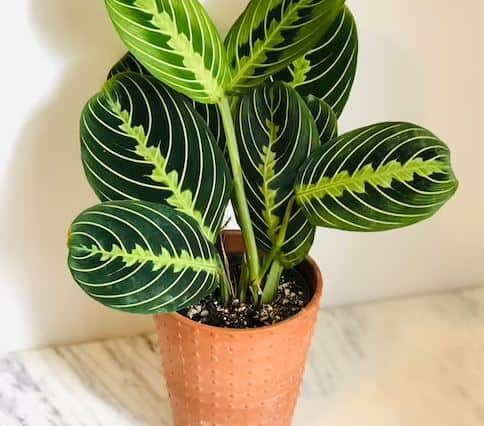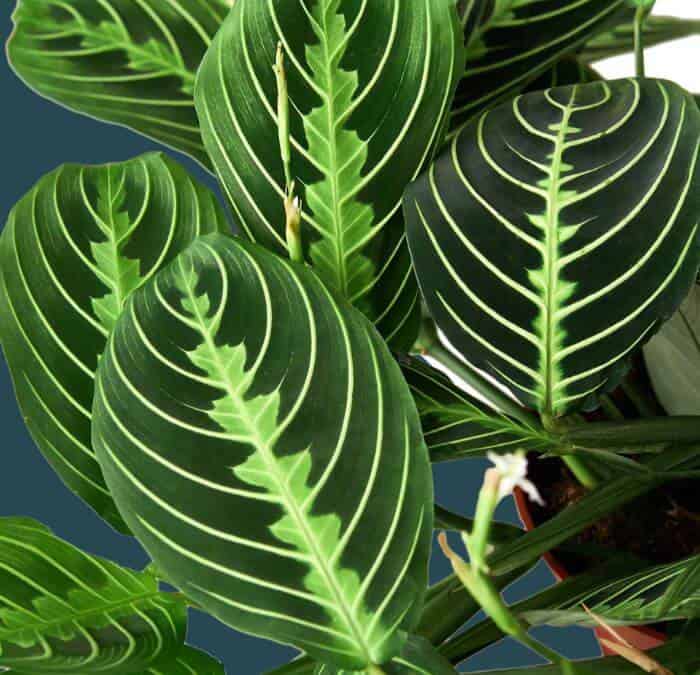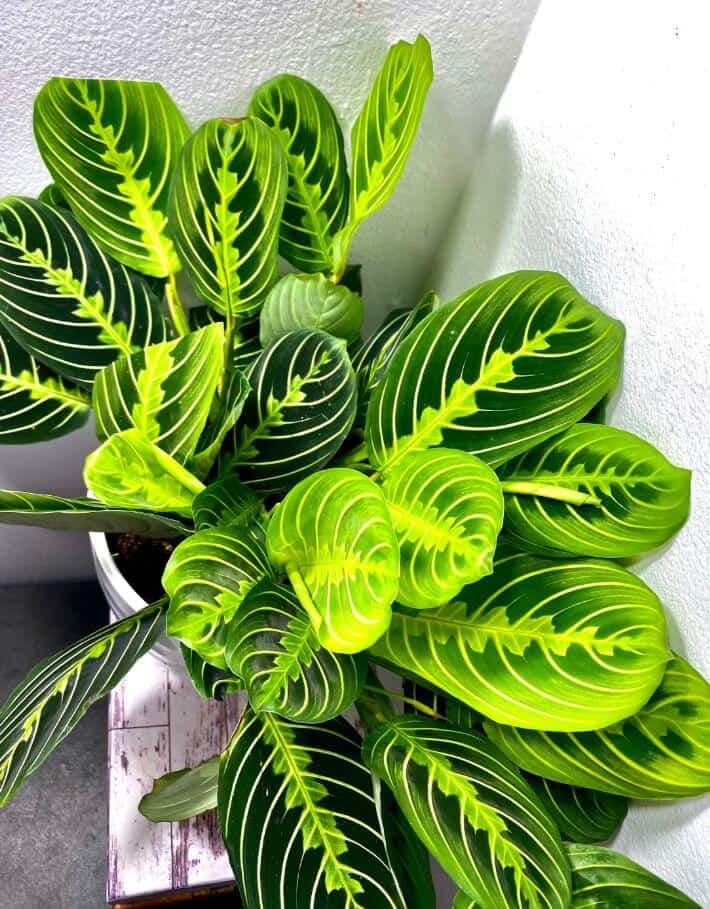Last Updated on January 7, 2023 by a Friendly Gardener
The most commonly grown prayer plant is the lemon lime prayer plant. Maranta leuconeura, as the plant is botanically known, is a great addition to the houseplants. It adds an attractive look to the surroundings growing in hanging baskets or as a floor planter.
The unique aspect of the prayer plants is how eerily their leaves look like praying hands when they open and close. The lemon line prayer plant stands out for its color and stunning foliage.
If you are looking to bring this beautiful plant into your home, you should know everything about its care. Read on to learn about lemon lime prayer plant care.
Lemon Lime Prayer Plant Care

Lemon lime prayer plant belongs to the Marantaceae family and is native to Africa, Asia, and Brazil. The unique plant undergoes an awe-inspiring phenomenon of praying with its leaves. The leaves open up when the day breaks in the manner of praying hands and close again when the sun sets.
The plant has tiny pink flowers that bloom slowly and may test your patience. However, its most attractive feature is the variegated leaves and not the inconspicuous flowers.
If taken care of properly, the evergreen plant will thrive and be an exceptional houseplant. Let’s go over how to take care of the prayer plant ‘lemon lime’.
Sunlight

While the plant tolerates low light, it thrives exceptionally well in indirect light. The plant does not appreciate direct sunlight. If the leaves of the plant begin to lose color, make sure the plant is not in the path of direct light.
For optimal results, keep the plant in a location filled with indirect light. If the plant begins to look washed out or shows a bleached effect, move it to a low-light space. This may help the plant regain its original color.
However, extremely reduced exposure to light can also cause the plant to suffer. In case you notice the leaves are not able to open up entirely in the morning, you will need to move the plant to a bright spot. Once the plant receives its required light, it will begin to recover.
Water
The prayer plant enjoys moist soil. Since the plants are native to humid, hot climates, water is an essential aspect of keeping them alive. Make sure you do not allow the soil to dry out during watering sessions. Keep the soil lightly moist at all times.
If possible, use warm water to water the plant. It creates a humid condition similar to their natural habitat. However, you will need to tone down the watering once the cold months roll by. In winter, the plant will be semi-dormant and will not require as much water as during hotter months.
Temperature
The optimal growing temperature for the plant is between 60 to 80℉. It usually cannot withstand lower or higher temperatures than this.
During summer, when the temperatures reach an adequate level, the plant may be placed outside in a partially shaded area. Once the temperature begins to drop, make sure your plant is brought indoors; otherwise, it will die from the cold.
Humidity
The lemon line prayer plant is at its best in high humidity conditions. If the humidity is low in your house, you will need to keep them in your kitchen or bathroom, where humidity tends to be higher.
Alternatively, you can place the plant over a tray filled with water and pebbles. You can also mist the plant regularly to mimic humidity. If you have other houseplants, place the prayer plant in the midst of them.
Soil

A well-draining soil in a properly draining pot will do wonders for the plant. The best potting mixes for the plant contain loam, sand, and peat moss. They help with drainage. The plant also prefers slightly acidic soil.
The plant has shallow roots, so make sure the pot is not too big. A large container may not allow the roots to absorb nutrients properly.
Fertilizer
The lemon lime prayer plant appreciates being fed during the growing season. Dilute a balanced liquid fertilizer and apply it to the soil every two weeks during the spring and summer months.
You can also opt for organic compost, emulsions, or worm castings. You can also sparingly use leftover tea leaves and mix them in the soil for healthy growth.
Do not fertilize the plant in winter. You can damage the roots if you feed the plant too much fertilizer when it is not required.
Pruning
Pruning helps keep the plant looking its best. Use a pair of sharp, clean garden shears or scissors to remove dead or decaying parts of the plant. It is considered normal for the plant to have old, unsightly foliage. Just remove it to allow room for fresh new growth.
Potting and Repotting

You are required to transfer the payer plant to a new pot every year. This is done to prevent soil compaction and allow the plants the ability to absorb fresh nutrients from the loose soil. Gently transfer the plant to a new pot during spring.
Diseases and Pests
Just like other houseplants, this plant is vulnerable to pests and diseases like mealybugs, spider mites, leaf spots, and brown leaves. In case the plant is growing in a poorly draining pot, it can deteriorate from root rot as well.
To prevent pests, ensure the plant is placed in humid conditions. Provide the plant with indirect light to avoid getting brown leaf tips. Overwatering can also result in browned tips and leaf spots.
Once an infestation or disease has been spotted, make sure to treat it immediately to prevent your plant’s health from declining further.
The Bottom Line

The lemon lime prayer plant is a stunning plant to have in your household. It loves bright, indirect light and a humid environment. If watered adequately and grown in well-draining soil, the plant will grow happy and healthy. With just the slightest effort, you can have a beautiful houseplant.

